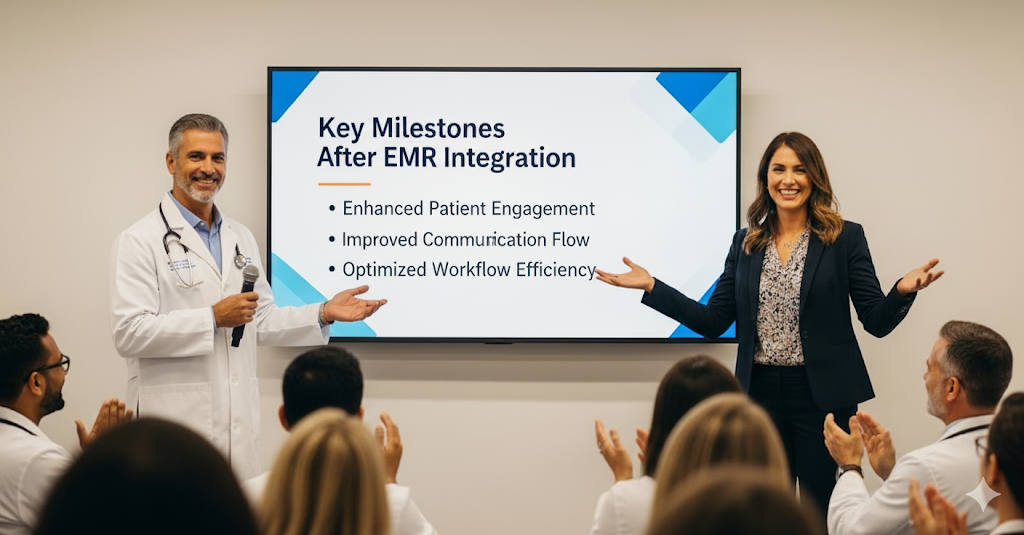How EMR System Integration Cuts No-Show Rates in Half
💡EMR integration reduces no-shows by making reminders automatic, accurate, and actionable. Disconnected systems leave gaps in communication,...
7 min read
Gregory Vic Dela Cruz : 9/4/25 3:00 PM
-1.png)
Every clinic knows the frustration of empty chairs in the waiting room. A provider’s schedule looks full on paper, yet patients don’t show up. These patient attendance challenges—commonly known as no-shows—are more than an inconvenience. They cost clinics thousands of dollars each year. And aside from stressing out staff, they delay necessary care for patients who need it most.
With one of every four patients not arriving for their scheduled visit, the reality is stark. For a clinic with 20 appointments a day, that’s 4–6 wasted slots daily. Multiply that over months, and the impact on both finances and patient care is staggering.
In this guide, we’ll break down the top five reasons patients miss medical appointments. By the end, we will have accomplished the following:
Quantify the financial and clinical impact of missed medical appointments.
Highlight strategies clinics can use to reduce no-shows.
Show how technology can close gaps in appointment systems, especially for eCW users.
Ready to transform your clinic's patient experience? Let's start by understanding the gravity at which no-shows harm clinics.
Across the United States, outpatient clinics face an average no-show rate of 20–30%. That means for every ten patients scheduled, two or three won’t show. These numbers aren’t just statistics—they translate into wasted time, disrupted schedules, and major financial losses. Certain specialties like behavioral health, imaging, and primary care see even higher rates, sometimes exceeding 40%. Understanding this baseline helps clinics measure their own performance and identify where improvement is needed.
The cost of missed appointments is significant. On average, each no-show represents $150–$300 in lost revenue. For a small practice with 20 daily appointments, a 25% no-show rate means up to $30,000 in lost revenue every month. Over a year, that figure can exceed $300,000. These losses affect more than just finances—they limit the clinic’s ability to reinvest in staff, equipment, and patient services. Beyond revenue, clinics face increased overtime costs as staff scramble to reschedule or catch up after disrupted schedules.
No-shows don’t just hurt the clinic—they harm patients too. When patients miss appointments, chronic conditions may go unmanaged, preventive care is delayed, and treatment outcomes suffer. A missed follow-up after surgery, for example, can lead to complications that require costly readmissions. Missed routine visits for conditions like diabetes or hypertension can result in worsening health and higher long-term costs. The impact ripples outward: missed appointments delay care for other patients as waitlists grow longer, creating access issues for the entire community.
In short, missed appointments are not a minor scheduling problem—they are one of the most pressing healthcare appointment barriers. Clinics lose revenue, staff lose time, and patients lose access to timely care. To solve the problem, we must first examine the root causes of no-shows.
The most common cause of no-shows is simple: patients forget. With work, school, childcare, and daily responsibilities, healthcare often slips down the priority list. Appointments scheduled weeks in advance are easy to overlook. Without reliable reminders, patients are more likely to miss or cancel at the last minute.
For many patients, especially those in rural or underserved areas, transportation is a major barrier. Long travel distances, unreliable public transit, or lack of access to a car can make it difficult to attend appointments. In urban settings, traffic congestion and parking challenges also play a role.
Fear and anxiety are often overlooked patient no-show reasons. Some patients worry about procedures, test results, or the possibility of bad news. Others may have had negative experiences with healthcare providers in the past. Anxiety becomes a hidden driver of missed appointments, particularly in mental health and specialty care.
Out-of-pocket costs are a growing cause of missed appointments in healthcare. Even patients with insurance often face high co-pays, deductibles, or outstanding balances. When the cost of attending a visit feels too high, some patients decide to skip altogether, prioritizing immediate financial needs over long-term health.
Miscommunication is another major reason why patients skip doctor visits. Patients may not understand appointment details, arrive at the wrong location, or fail to follow preparation instructions. A simple mix-up—like fasting when it’s not required, or failing to fast when it is—can lead to canceled or missed visits. These issues are preventable with clear, consistent communication.
These five common reasons for missed medical appointments highlight that most no-shows are not due to patient neglect but to systemic barriers and communication gaps. Addressing them requires proactive strategies.
Each missed appointment equals immediate lost revenue. For a clinic charging $150 per visit, 20 missed appointments a week equal $3,000 in losses. Over a year, that’s more than $150,000—money that could have been invested in new staff, upgraded equipment, or expanded services. Beyond the dollars, no-shows reduce provider utilization. A physician’s time goes unused, making schedules unpredictable and undermining the financial stability of the practice.
No-shows add administrative workload. Staff spend hours calling patients to reschedule, leaving voicemails, and managing last-minute cancellations. These repetitive tasks contribute to burnout and turnover. Replacing a burned-out staff member costs 20–30% of their annual salary, further adding to the hidden costs of no-shows.
No-shows create longer wait times for patients who need care. When slots go unused, other patients must wait weeks—or months—for an appointment. For urgent cases, this delay can worsen outcomes and reduce patient trust in the clinic. Patient frustration often translates into negative reviews, which can hurt the clinic’s reputation and future revenue.
The hidden costs of missed appointments ripple through the healthcare system. Clinics lose money. Staff morale declines. Patients face delays. Over time, this cycle undermines both operational efficiency and patient outcomes. Addressing the root causes of no-shows is essential to breaking this cycle and building a sustainable clinic workflow.
.png?width=1536&height=1024&name=why%20patients%20miss%20appointments%20-%20mid%20(1).png)
One of the most effective ways to reduce no-shows is through automated appointment reminders. Texts, calls, and emails sent at intervals (72h, 24h, 2h) significantly increase attendance rates. Patients can confirm or reschedule with a single tap, making scheduling more efficient.
Offering same-day slots, extended hours, or telehealth visits reduces scheduling barriers. Patients with transportation challenges or unpredictable work schedules benefit from this flexibility.
Providing simple, step-by-step instructions via text or email eliminates confusion. Reminders with location maps, fasting requirements, or telehealth links ensure patients arrive prepared.
Unpaid balances are a major healthcare appointment barrier. Digital payment tools allow patients to clear balances before the visit. Similarly, digital intake forms reduce wait times and eliminate paperwork errors, creating a smoother experience that encourages attendance.
eCW users have a unique advantage: access to real-time scheduling data. By syncing this data with a communication platform, reminders are accurate and always up to date. Patients trust reminders that match their actual appointments.
Integrated messaging ensures that all communication—reminders, intake forms, payment requests—ties back to the EMR. This creates consistency, reduces errors, and builds trust with patients.
Instead of relying on phone calls and generic reminders, clinics can instead use Curogram. They get a HIPAA-compliant, automated communication layer that makes every interaction smoother. Here’s how:
With Curogram, eCW evolves from just a scheduling system into a complete patient communication hub. Every message is secure, every reminder accurate, and every appointment more likely to happen. That means fewer empty chairs, happier patients, and more productive staff—all without adding more manual work.
By understanding why patients miss their appointments, clinics can find the right solutions. The impact of no-shows extends far beyond empty chairs. It also affects provider utilization, staff morale, patient satisfaction, and clinic growth.
The good news is that no-shows are preventable. With the right strategies, clinics can cut no-show rates dramatically. These strategies should include automated reminders, flexible scheduling, digital payments, and EMR integration. And for eCW users, using a platform like Curogram makes these strategies seamless. It delivers HIPAA-compliant messaging, smart reminders, and digital intake all in one place.
Want to see how Curogram helps clinics cut no-shows by up to 75%? Schedule your free demo today and transform the way your clinic manages appointments.

💡EMR integration reduces no-shows by making reminders automatic, accurate, and actionable. Disconnected systems leave gaps in communication,...

💡Covina Arthritic Clinic boosted revenue by streamlining appointment confirmations with Curogram’s integrated system. By automating reminders and...
.png)
💡The key to improve clinic efficiency lies in strategies that reduce admin burden. Doing so improves patient flow without hiring and increases...